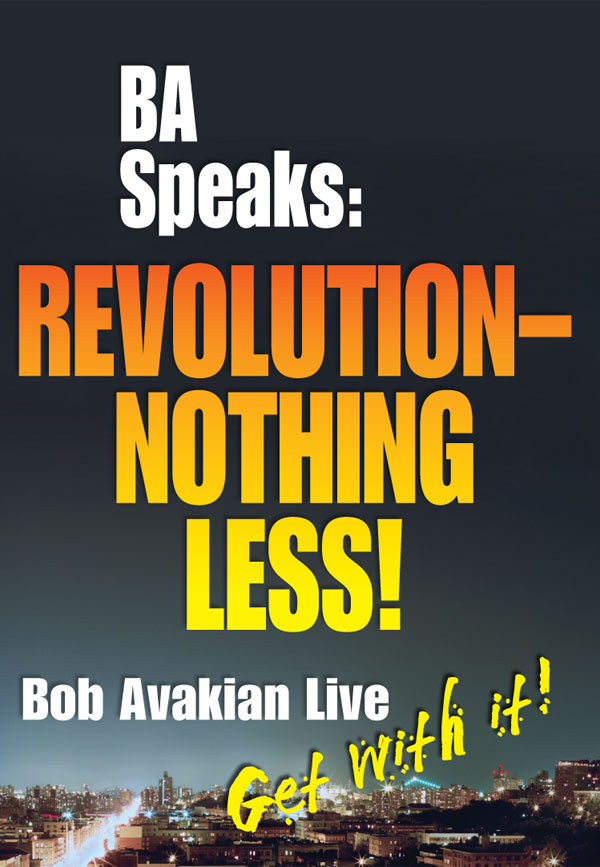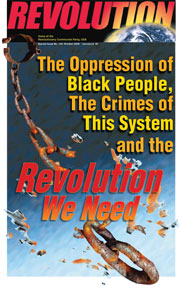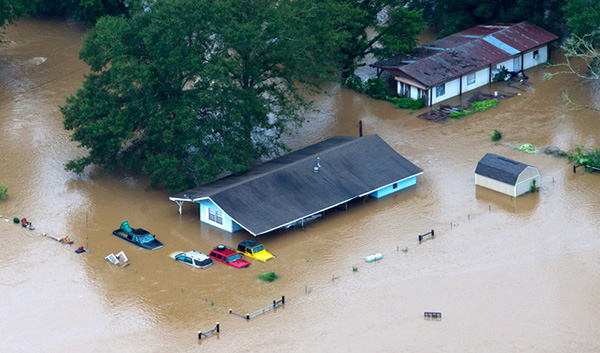
Starting on Thursday, August 11, a relentless downpour produced a major flood crisis throughout southern Louisiana. Tens of thousands of people have been evacuated from their homes. At least 13 people are dead. Above: an aerial photo shows people being rescued from flooded homes along the Tangipahoa River near Amite, Louisiana, August 13. (Photo: Ted Jackson/NOLA.com The Times-Picayune via AP)
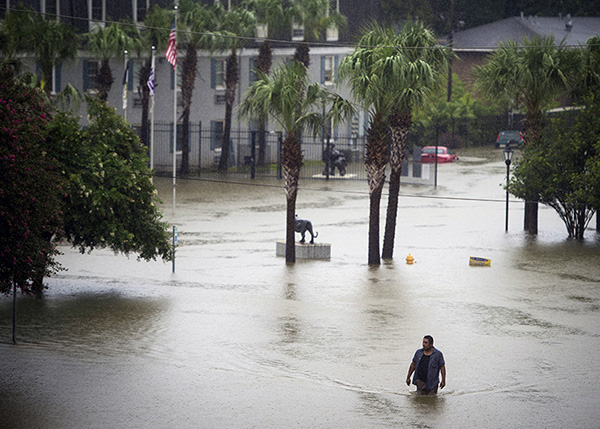
There has been a stunning lack of assistance from the government during and in the aftermath of the flood. Government services essentially collapsed for days. Above: A resident wades through floodwater at Tiger Manor Apartments by Louisiana State University in Baton Rouge, August 13. (Photo: Brianna Paciorka/The Advocate via AP)
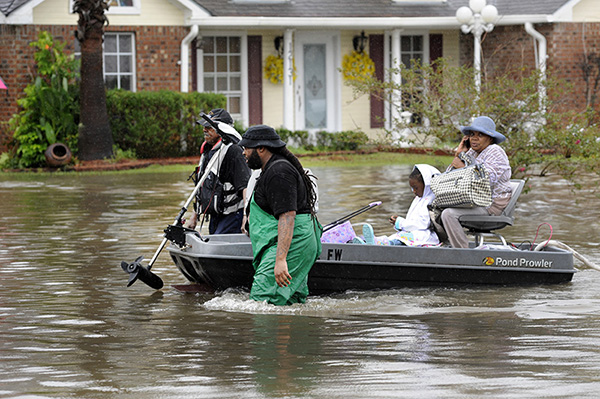
A woman told Revolution: “Everywhere that I went there were large groups of young Black men, some of them in boats for the first time in their lives—they never even been in a boat but they were in them to try to save people out of their homes.” Above: Volunteers pull a boat with a woman and young child as people evacuate their homes, Baton Rouge, August 13. (Photo: John Oubre/The Advocate via AP)
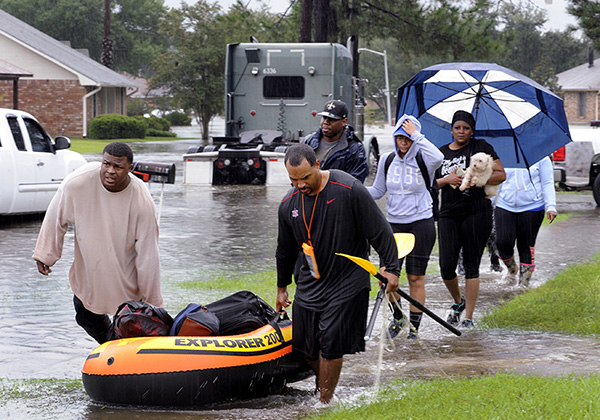
A woman told Revolution: “In Baton Rouge? Nah, haven’t seen them [the authorities] do anything to help people. But the people in that community were amazing. They didn’t have much, but they were focused on helping us....They talk about looting, but I didn’t see any of that. I didn’t hear any about it either. But I did see a lot of people helping each other out.” Above: People evacuating a flooded neighborhood in Baton Rouge, August 13. (Photo: John Oubre/The Advocate via AP)
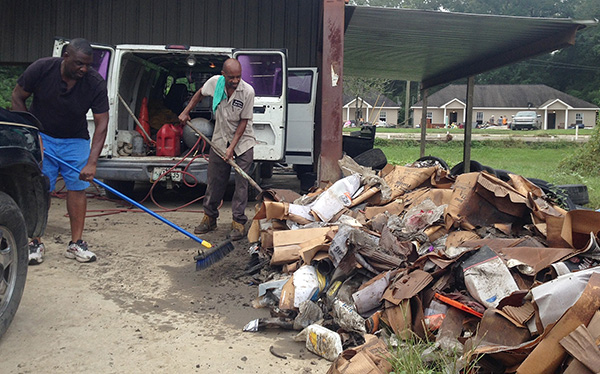
Tens of thousands of homes have been irreparably damaged. In Livingston Parish (county), east of Baton Rouge, 75 percent of the homes are a total loss. Rotting, stinking furniture and belongings have been hauled out to the streets. Above: Men pile up debris outside a flooded auto parts store in Albany, Louisiana, August 17. (AP photo)
The Louisiana Flood: A Natural Disaster, A Disastrous System
August 22, 2016 | Revolution Newspaper | revcom.us
From a Revolution correspondent reporting from Baton Rouge, Louisiana:
On August 11, a wave of torrential rain hit the area in and around Baton Rouge, Louisiana. Day after day of relentless downpours produced a major flood crisis throughout southern Louisiana. Tens of thousands of people have been evacuated from their homes, over a large area stretching from Lafayette east to Baton Rouge and beyond. At least 13 people are dead. Tens of thousands of homes have been irreparably damaged. One official said that in Livingston Parish (county), east of Baton Rouge, 75 percent of the homes are a "total loss." Many schools, churches, and community centers are shut down; it is uncertain when or if they will reopen. As CNN reported about the rains that soaked Louisiana, "This disaster is the worst to hit the United States since Superstorm Sandy."
Unearthed coffins drifted down the main streets of towns. Snakes and even fish entered people's living rooms. People who took a wrong turn while seeking safety found themselves suddenly engulfed with water that made their cars inoperable, and sometimes were swept away by the deluge. People were stranded without necessary medication for diabetes, cancer, and other life-threatening conditions. Bodies were found washed up on riverbanks, or by roadsides. Shit and waste from sewers backed up and filled people's kitchens and bedrooms.
Everywhere, people told stories of water that engulfed their homes quickly, not a gradually seeping intrusion. One man told the Associated Press that water had reached waist level outside his mobile home Thursday night, and that he had seen an alligator swim by. One woman told us, "I have friends of mine that said they were walking in the water, trying to get out, to escape the water up to their chest and sometimes up to their chins. I am talking men, 6'1"; 6'3", OK? Water was just still and then the current got so strong that they could hardly stand up, like instantly something happened and the water was just coming in from nowhere, coming, coming, coming from nowhere."
Abandoned by the System
There has been a stunning lack of assistance from the government during and in the aftermath of the flood. Government services essentially collapsed for days. The vast majority of people rescued from flooded homes were rescued by volunteers. Conditions in shelters were, and are, appalling. The most vulnerable are not cared for but sleeping on cots left to their own devices to survive. People who were evacuated left life-saving medicine behind, without any access to replacement.
An area that is already one of the poorest in the U.S. has sustained at least $20 billion of residential property damage. Filth and the waterlogged wreckage of people's lives line the streets across the areas of Louisiana known as Acadiana and the Florida Parishes.
Countless people don't know if they have jobs they once held. A woman we spoke to said she had joined a cleanup crew for meager pay because her employer told her that her job was gone "until further notice." Many others have lost the ability to get to jobs that may still be there—thousands of cars have been destroyed in an area with virtually no mass transit.
A toxic sludge covered much of a region renowned for its emerald beauty and abundant wildlife. Now, the air in the region is blanketed with a nauseating stench, and no one really knows about the water. One woman told Revolution: “ The city stinks.... it literally smells like sewage; you know, like raw sewage ... foul odors everywhere you breathe.”
In desperate straits, people are being told to enter into the bureaucracy of applying for federal assistance or to try to collect on flood insurance—something only a tiny percentage of homeowners can afford. Meanwhile, the governor appeals for charity and donations.
Baton Rouge's "Mason-Dixon Line"
The impact of the flood was determined in part by where the rain came down the hardest. But the impact was also determined by the nature of this system, including the reality that white supremacy is tightly woven into everything about how this system works, and how people live and how people think.
The actual impact of flooding hit hardest in overwhelmingly white areas outside the city of Baton Rouge. These are sprawling communities of small, one-story homes of people who work for some of the lowest wages in the U.S. For many of them, the equity they have in their homes provides what little financial security they have. For the vast majority who couldn't afford flood insurance, the long-term impact of the flood will be devastating. Mainstream news coverage of the impact of flooding in overwhelmingly white areas emphasized and spread unfounded rumors of looting. CNN coverage featured property owners on armed "looter patrols" with the unstated but clear implication that the danger came from Black people from nearby Baton Rouge.
Baton Rouge itself is about half Black, and rigidly segregated. During the Civil War, the “Mason-Dixon line” separated the slave states that formed the Confederacy from the North. Many people in Baton Rouge refer to Florida Boulevard, a major east—west street, as the “Mason-Dixon line” of Baton Rouge. To the south of Florida Boulevard, the population is largely white; north of it, almost all Black people.
The most pervasive property damage took place east of Baton Rouge. But the most severe impact on people’s lives was in the north side of the city. A man in North Baton Rouge said there were no rescue teams sent into his heavily flooded area until "three, maybe four days later." When authorities arrived, it was to enforce curfews and prevent "looting"—not to save lives. In a country where for large sections of society, there are almost unlimited ways to shop and buy stuff, the most basic essentials of survival were not accessible to thousands. Based on what people told us, there was very little of what the system calls "looting," and overwhelmingly it was people getting desperately needed food and medicine that was not available any other way.
North Baton Rouge is where police murdered Alton Sterling on July 15 in front of the Triple S store. The store and the immediate area around it were not flooded, but many nearby streets were under water. One woman in that community told Revolution, "They tell people to go to the shelter, when there are literally no cars in the street. People had to get out of their cars because the water rose so rapidly. They have no transportation. They have no vehicle. They have nothing.
 The Constitution for the New Socialist Republic in North America (Draft Proposal) from the RCP is written with the future in mind. It is intended to set forth a basic model, and fundamental principles and guidelines, for the nature and functioning of a vastly different society and government than now exists: the New Socialist Republic in North America, a socialist state which would embody, institutionalize and promote radically different relations and values among people; a socialist state whose final and fundamental aim would be to achieve, together with the revolutionary struggle throughout the world, the emancipation of humanity as a whole and the opening of a whole new epoch in human history–communism–with the final abolition of all exploitative and oppressive relations among human beings and the destructive antagonistic conflicts to which these relations give rise.
The Constitution for the New Socialist Republic in North America (Draft Proposal) from the RCP is written with the future in mind. It is intended to set forth a basic model, and fundamental principles and guidelines, for the nature and functioning of a vastly different society and government than now exists: the New Socialist Republic in North America, a socialist state which would embody, institutionalize and promote radically different relations and values among people; a socialist state whose final and fundamental aim would be to achieve, together with the revolutionary struggle throughout the world, the emancipation of humanity as a whole and the opening of a whole new epoch in human history–communism–with the final abolition of all exploitative and oppressive relations among human beings and the destructive antagonistic conflicts to which these relations give rise.
Read the entire Constitution For The New Socialist Republic In North America (Draft Proposal) from the RCP at revcom.us/rcp.
"And it was like we were almost trapped here. Roads were closed. We had nowhere to go. My sister and cousins and nieces and nephews and Facebook friends were calling me and like 'where are we going? where can we go? how can we get out? You know, if the water starts rising again, how can we leave?' I had no answers. I don't know."
A man in North Baton Rouge took us into his home. He had returned from work to find two feet of water in his house. He said he wasn't able to save anything except some cooking utensils. The water line in the house showed the flood had risen to about 5 ½ feet. His home, like every other one on the street he lived, was already mildewed, despite his efforts at cleaning it up. He and his family went to the home of some relatives—and that night were flooded out again. He had spent two days cleaning up, and told us that not only is all they had ruined, "everything still smells bad, inside and out."
The Real Heroes
While the system abandoned people, people struggled heroically to save each other, to help each other out.
A woman told us, "Everywhere that I went there were large groups of young Black men, some of them in boats for the first time in their lives—they never even been in a boat but they were in them to try to save people out of their homes."
Another young woman stranded on a freeway for 30 hours told us that "I do give much respect to the community out there, because they did come out, and provide water and food to the people stuck on the highway. They made sure the kids had what they needed. They went to they houses and cooked food for us....
"In Baton Rouge? Nah, haven't seen them [the authorities] do anything to help people. But the people in that community were amazing. They didn't have much, but they were focused on helping us. But the police? Nah. They talk about looting, but I didn't see any of that. I didn't hear any about it either. But I did see a lot of people helping each other out."
Unnecessary Suffering
Southern Louisiana is a verdant, lush, semi-tropical landscape. It is ribboned by numerous rivers and bayous; dotted with lakes, ponds, and swamps. Some have overflowed before, causing damage and even loss of life. This is a region where fierce rainstorms are not unusual. And on a global scale, scientists are identifying patterns of more frequent and more extreme weather events, linked to climate change.
Katherine Hayhoe, a climate research scientist at Texas Tech University, said, "Louisiana is always at risk of floods, naturally, but climate change is exacerbating that risk, weighting the dice against us. How long will it be until we finally recognize that the dice are loaded?"
It is obvious that society needs to take a serious and planned approach to anticipate and respond to the danger of flooding in this region, including how to ensure the most basic necessities of life. But that doesn't fit into the "logic" of capitalism. Capitalism is based on and enforces private ownership over the social means of producing wealth and the resources of society. Its logic is NOT human need, but just the opposite: competitive drive for profit that is as relentless and ferocious as the storm that hit Baton Rouge.
People should ask themselves—why is society organized in such a way that any human's ability and right to live are determined ultimately by how this can contribute to the profits of capitalists? People should ask themselves, is this the world they want to continue living in? And they should dig deeper—is this the only kind of world that is possible?
The answer is—no, it isn't. Natural disasters will continue to confront humanity, including in a future socialist society. But when something like this flood happens—the need to maximize profit and put that as first and foremost does NOT need to set the terms for how society responds.
To bring about that kind of fundamental change requires an ACTUAL revolution. In a New Year's message delivered at the beginning of 2014, but at least as timely today, Bob Avakian said:
Revolution is not an impossible dream. It is not "unrealistic." Changing all of society, changing the whole world, is not a crazy or dangerous idea. What is crazy, and dangerous, is going along with the way things are, and where things are heading, under this system. Revolution—a radical change in how society works, how we relate as human beings, what our values are, how we understand the world and act to affect it—this is what we, what people all over the world, desperately need. And it is a lot more realistic than trying to "fix" this system.
(From "This is Bob Avakian, Chairman of the Revolutionary Communist Party, with a New Year’s message—A Call To REVOLUTION")
Because of Bob Avakian and the work he has done over several decades, there really is a viable vision and strategy for a radically new, and much better, society and world, and there is the crucial leadership that is needed to carry forward the struggle toward that goal. And based on that, there is a Constitution for the New Socialist Republic in North America (Draft Proposal). This is a blueprint for a new and totally different state power. It is as serious as it is liberating.
Volunteers Needed... for revcom.us and Revolution
If you like this article, subscribe, donate to and sustain Revolution newspaper.




